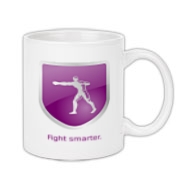One of the greatest programing challenges for instructors and coaches of fight and self defense athletes is coming up with training ideas for the recovery or injury prevention periods of the training cycle.
Here’s a suggestion; use the time to practice established skills in new ways. Mastery of athletic skills requires the ability to adapt them to a variety of environments and conditions. Many established skills can be regressed allowing safe, low-intensity practice in ways that would have been unproductive, or needlessly difficult during the initial skill acquisition phases of training.
Many fight athletes— especially those who have not practiced sports that emphasize attending to non-visual information in their youth have some difficulty reacting quickly and appropriately to auditory, proprioceptive, and tactile information.
Quick and appropriate responses to non-visual information can substantially improve performance and reduce the risk for injuries. Including training to enhance reactivity to non-visual information can substantially enhance skill mastery while contributing to performance.
Ideally this type of training involves progressions from very simple and not particularly reactive, to complex and substantially reactive— while allowing the student time to experience the differences in performance represented by each step along the way.
Two very basic grappling skills that we practice at FSRI are mount escapes and guard sweeps. Because these are simple, yet crucial skills that when practiced slowly and carefully represent a low risk for injury, and because most of our students have significant experience practicing them they are great candidates for this sort of training.
These can each be rehearsed a few times as “dead” drills requiring no reactivity whatsoever. After that the person affecting the escape closes their eyes and performs the drills as before. Once they are in the superior position, they reopen their eyes. This is done slowly without much intensity.
Excessive coaching here is not productive. Their partners and their coaches watch the environment for hazards and intervene only where there may be a danger to the participants. The intension is to allow the participants to experience the drills in new ways.
Next coaches should introduce some small degree of reactivity. The partner in the mount position (for example) can change their weight, or post with a particular limb in a way that requires the person practicing the escape to find an appropriate response. This is also practiced far below performance speeds or intensities.
Finally the environment can be manipulated through a variety of means. A simple one involves blindfolding the person practicing the escapes and placing them in unusual locations on the training floor-such as near a padded wall then asking them to perform the drills. Small pillows can also be randomly placed around the mat and the person practicing the escapes can be coached to scoot around and avoid them as they practice.
Valleys can be created in the wrestling mats by placing pillows or cushions under it in places. This can be especially relevant for people interested in practicing escapes from attacks that might occur on compliant surfaces such as beds, car seats, or couches.
Being “stuck” in a valley can be an especially difficult challenge so coaches should watch this one carefully as frustration may result in the intensity escalating beyond what is appropriate for blinded training during the recovery phase. Coaches should avoid making the engagements too difficult in this phase. Slight elevations in the mats can significantly change the experience of the drills. Remember that the goal is to enhance spatial and positional awareness and improve reactivity to non-visual information at this stage, not to needless frustrate students or increase the risk of injury.



 are available here.
are available here.